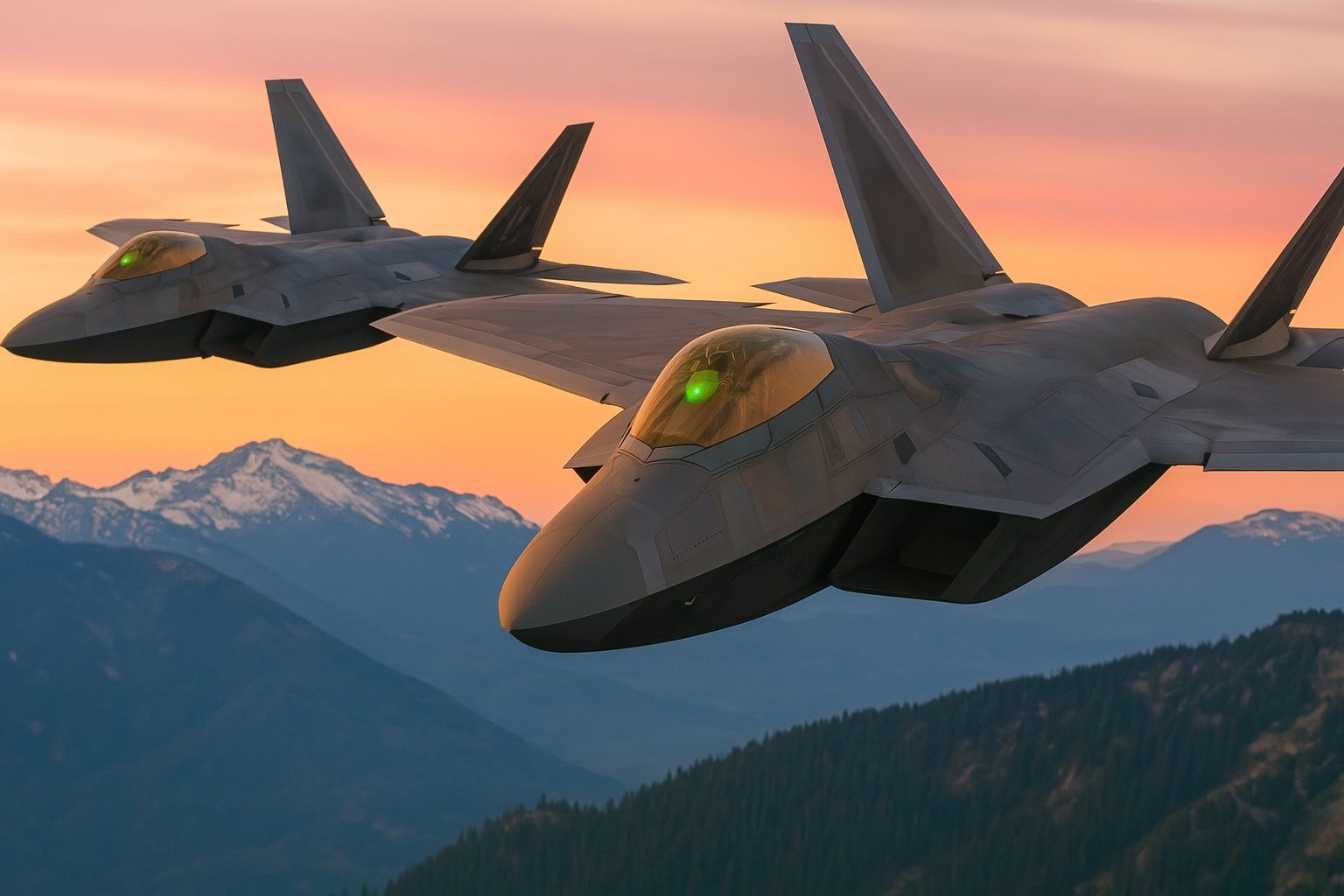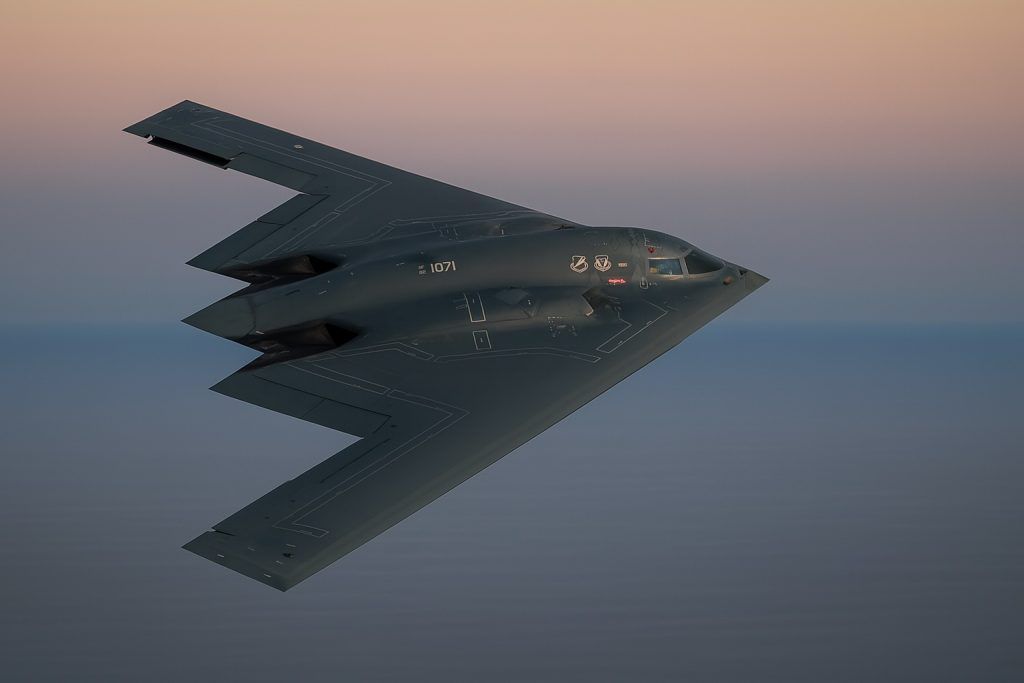- In June 2025, F-22 Raptors from the 1st Fighter Wing deployed from Langley AFB to the Middle East as part of Operation Midnight Hammer, joining a strike package of 125 U.S. aircraft including B-2 bombers dropping 30,000-pound bunker-buster bombs on Iran’s Fordow and Natanz, marking the Raptor’s first direct strikes against a nation-state.
- On July 8, 2025, a USAF KC-46A Pegasus tanker suffered a mid-air refueling boom separation while refueling F-22s off the U.S. East Coast, the F-22 returning safely with no damage, and it was the second such KC-46 boom detachment in a year.
- In January 2025 Lockheed Martin received a $270 million contract to integrate a new Infrared Defensive System (IRDS) on the F-22, replacing the AN/AAR-56 and enhancing long-range missile detection.
- The FY26 budget ordered 30 IRST pods, in two lots of 15, external underwing pods to allow passive infrared tracking of other aircraft with first deliveries expected by mid-2028.
- The Low Drag Tank and Pylon program is developing 600-gallon stealth drop tanks and pylons that enable Mach 1.2 with tanks attached, with full supersonic certification expected by late 2025 and initial operating capability in 2026.
- AIM-260 Joint Advanced Tactical Missile (JATM) is slated for integration on the F-22 to outrange China’s PL-15, with flight testing underway and a concept image of a Raptor launching JATM released by General Mark Kelly.
- The viability upgrade package includes the Thales Scorpion Helmet-Mounted Display, restoring helmet sight for off-boresight targeting.
- FY26 funding (~$15 million) will start Crewed-Platform Integration to add tablet-based CCA control stations in the F-22 cockpit from 2026, with all combat-coded F-22s (143 jets) eventually able to command autonomous wingmen via the IFDL datalink.
- There were no F-22 retirements in 2025, with the fleet remaining around 185 aircraft and about 153–154 combat-capable after potential Block 20 divestment.
- The U.S. awarded Boeing a contract in 2025 to develop the F-47 NGAD, with the FY26 budget request of about $3.5 billion to accelerate it and plans to buy 185+ F-47s as a one-for-one replacement for the F-22, illustrating the Raptor’s role as a bridge to NGAD.
All F-22 Raptor Developments in 2025
The legendary F-22 Raptor stealth fighter has had a pivotal year in 2025, marked by high-stakes combat operations, ambitious modernization plans, and fierce debates over its future. From spearheading airstrikes in the Middle East to receiving cutting-edge upgrades aimed at countering rising threats, the F-22 has proven why it remains one of the world’s most formidable fighter jets. This in-depth roundup covers all the major developments – operational deployments and incidents, upgrade programs, fleet changes and retirement plans, expert commentary, U.S. policy moves, and even international reactions – that defined the Raptor’s dramatic year.
Combat Deployments and Operational Highlights
Middle East Showdown – Operation Midnight Hammer: In June 2025, F-22 Raptors were thrust into a major conflict when the U.S. launched Operation Midnight Hammer – a massive strike on Iran’s nuclear facilities amidst a nascent Iran-Israel war. Multiple F-22s from the 1st Fighter Wing deployed from Virginia to the Middle East (via a stop at RAF Lakenheath in the UK) as part of the American build-up [1] [2]. On the night of June 22, they joined a strike package of 125 U.S. aircraft – including B-2 stealth bombers dropping 30,000-pound bunker-buster bombs on Iran’s Fordow and Natanz nuclear sites – in one of the largest stealth air raids in history [3] [4]. The F-22s escorted strike assets and provided air dominance, ensuring no Iranian fighters or air defenses could interfere [5]. According to Air Force officials, the Langley-based Raptors “participated in the strikes on Iran” and began returning home in early July once their mission was complete [6]. This marked the first use of the F-22 in direct strikes against a nation-state’s forces, a milestone underscoring its value even 20 years after entering service.
Tensions and Air Patrols: The Iran conflict wasn’t the only hotspot. Earlier in the year, U.S. F-22s had been forward-deployed to the Middle East (and other regions) as a deterrent amid various crises. U.S. Central Command had rushed Raptors to the Persian Gulf in late 2024 when Iran and its proxies stepped up drone and missile attacks, with Raptor pilots shifting from their usual role of hunting advanced enemy fighters to the gritty work of shooting down Iranian-made drones [7] [8]. “We were primarily there to defend our ground forces against…UAVs…as well as cruise missiles,” explained Lt. Col. Dustin Johnson, an F-22 squadron commander, of the unusual drone-defense missions [9] [10]. The F-22’s advanced AN/APG-77 AESA radar helped detect and down dozens of small drones, though their low speed and tiny radar signature made for a tricky target [11] [12]. Meanwhile in Europe and the Pacific, the high-demand Raptors continued rotational deployments to reassure allies. In the Indo-Pacific, F-22s are “often sent…[but] there is a limited number of these aircraft, and tensions are rising,” noted one report [13]. And nearer to home, F-22s at Alaska’s Elmendorf base remained on guard: U.S. NORAD units regularly intercept Russian aircraft approaching Alaskan airspace, and the Raptor has even squared off with Russia’s Su-35 fighters and Tu-95 bombers in recent years (an unprecedented encounter occurred when F-22s intercepted armed Russian Su-35s near Alaska for the first time) [14]. These operations in 2025 underscored the F-22’s role as the tip of the spear in crisis response and air sovereignty missions around the globe.
Refueling Mishap – KC-46 Incident: One headline-grabbing incident highlighted the challenges of supporting such operations. On July 8, 2025, a USAF KC-46A Pegasus tanker suffered a serious mishap while refueling F-22s off the U.S. East Coast. Mid-air over Virginia, the KC-46’s refueling boom unexpectedly broke off and detached from the tanker during an hook-up with a Raptor [15] [16]. The tanker crew declared an in-flight emergency and diverted to land at Seymour Johnson AFB, NC, while the F-22 safely returned to Joint Base Langley-Eustis with no damage [17] [18]. “There was damage to the KC-46’s boom…[we’re] determining the nature and causes,” an Air Force spokesperson stated, confirming that the Raptor landed safely after the boom separation [19]. This incident – the second time a KC-46 boom has ripped off in flight within a year – highlighted ongoing tanker technical issues but fortunately caused no loss of a Raptor. It also illustrated the complexities of the F-22’s worldwide deployments, which rely on robust aerial refueling to project the jet’s power across oceans.
Modernization and Upgrades: Raptor Revival
Facing rapidly evolving threats, the U.S. Air Force in 2025 kicked off a major F-22 modernization drive to ensure the Raptor dominates well into the 2030s. After years of incremental upgrades, this year saw a raft of new enhancements funded and unveiled – so much so that observers dubbed it the F-22’s “modernization moment” [20]. “A more modern F-22 will need additional mission capacity,” said Caroline Cooper, F119 engine program director at Pratt & Whitney, emphasizing how new capabilities are being integrated to keep the Raptor lethal in the face of rising great-power threats [21]. Below we break down the key upgrades underway:
- Infrared Sensors and Defensive Suite: In January 2025, Lockheed Martin received a $270 million contract to integrate a new Infrared Defensive System (IRDS) on the F-22 [22]. IRDS is essentially a next-generation missile launch warning and tracking system using multiple infrared sensors to detect incoming air-to-air or surface-to-air missiles at long range [23] [24]. It will replace the Raptor’s legacy AN/AAR-56 Missile Launch Detector with “newly developed” IR sensors that vastly improve threat detection and situational awareness [25] [26]. The IRDS is part of a broader sensor upgrade focused on countering advanced Chinese and Russian missiles – a pressing need as intelligence warns of adversary missiles with ranges up to 1,000 miles by 2050 [27]. In fact, the Chinese PL-15 long-range air-to-air missile (operational today) was a wake-up call that spurred the U.S. to develop the AIM-260 JATM missile in response [28]. The IRDS will leverage Lockheed’s TacIRST passive infrared search-and-track technology, first demonstrated in 2022, to give Raptors a sensor somewhat akin to the F-35’s 360° Distributed Aperture System [29] [30]. It aims to provide earlier warning of distant missile launches, even from stealthy or low-signature threats, without relying on radar [31] [32]. The Air Force budgeted $90 million in FY2026 to move IRDS toward production, with a decision on low-rate initial production expected by late 2026 [33] [34]. If all goes to plan, full-rate production and fleet installation will occur by 2028–2029 [35]. In short, the Raptor is getting eyes in the infrared spectrum, enhancing its ability to “see” stealthy adversaries or incoming missiles in silence (since IR sensors are passive and immune to jamming) [36].
- “Viability” Upgrade Package: The IRDS is just one piece of a larger suite of “viability upgrades” the Air Force unveiled in its FY2026 budget request. This comprehensive package is meant to “keep the F-22 relevant” and counter emerging threats through hardware and software enhancements [37]. According to budget documents, the viability upgrades cover a cocktail of improvements: stealth signature reduction, radar enhancements (including more dynamic synthetic-aperture radar modes), an improved electronic warfare (EW) suite to counter new enemy jammers, an upgraded pilot-vehicle interface (potentially new cockpit displays or controls), next-gen cryptography for secure communications, advanced cybersecurity, and more [38] [39]. Notably, a long-cancelled capability will finally reach Raptor pilots – a Helmet-Mounted Display (HMD). After decades without a helmet sight, F-22 pilots are now set to receive the Thales Scorpion HMD, giving them off-boresight targeting and enhanced situational awareness [40]. (The lack of a helmet sight in F-22s has been “increasingly pronounced in recent years,” one report dryly noted [41].) The viability program will also include a mysterious “Project Keystone” to install an advanced threat-warning receiver in the jet [42]. All these enhancements are aimed at preserving the F-22’s first-look, first-shot, first-kill edge against peer adversaries [43]. The effort is backed by significant funding – over $4.3 billion from FY23–29 – signaling the Air Force’s commitment to its premier fighter [44]. As War Zone’s analysts put it, this is “an array of new ‘viability’ upgrades to help protect [F-22s] from emerging threats and ensure their continued relevance in future conflicts” [45]. In other words, the F-22 is getting a second wind technologically, not fading away.
- Podded IRST and Stealthy Fuel Tanks: Separate from the IRDS, the F-22 is finally receiving a capability it long lacked – an Infrared Search and Track (IRST) system for air-to-air use. The Air Force confirmed this year that the Raptor will get IRST in the form of external underwing pods (to avoid extensive airframe modifications) [46] [47]. In fact, testing of stealthy IRST pods and even new conformal fuel tanks has been underway for years; Raptors were spotted flying with prototype sensor pods and fuel tanks as early as 2022 [48] [49]. The FY26 budget reveals the Air Force already ordered 30 IRST pods (in two lots of 15) and expects the first units delivered by mid-2028 [50] [51]. These pods will house advanced long-range IR sensors allowing Raptors to passively track other aircraft by their heat emissions – a crucial tool for detecting stealthy foes or engaging without giving away one’s presence. Interestingly, the IRST pods could work in tandem with the new IRDS; multiple IR sensors networked together can triangulate targets at long range, providing “engagement-quality” tracks without radar [52] [53]. Lockheed has demonstrated such networked IRST targeting in past experiments, pairing Legion Pod IRSTs on different aircraft to pin down targets in 3D space [54]. The possibility of fusing IRDS and IRST data on the F-22 has experts excited about a “powerful combination” of sensor coverage [55] [56]. Alongside sensors, stealthy drop tanks are also in development to extend the Raptor’s range. The Low Drag Tank and Pylon (LDTP) program is crafting 600-gallon tanks and pylons that minimize drag and radar signature, enabling F-22s to cruise faster and farther without sacrificing stealth when tanks are jettisoned [57]. Unlike conventional external tanks, these have shaping and smart ejector mechanisms to allow supersonic flight up to at least Mach 1.2 with tanks attached [58]. In a rendering released by Air Combat Command, an F-22 is shown carrying two such drop tanks underwing and even firing the upcoming AIM-260 missile, illustrating the Raptor of the near-future: equipped with IRST pods, stealth tanks, and new missiles [59] [60]. The tank project completed critical design review in early 2023, and initial flight tests (up to Mach 0.95) are in progress; full supersonic certification is expected by late 2025, with initial operational capability slated for 2026 [61] [62]. These additions will help mitigate one of the F-22’s few shortcomings – limited combat range – which is vital in the vast Pacific theater.
- Weapons and Software Upgrades: To complement its new sensors, the Raptor is being armed with next-generation weaponry. The AIM-260 Joint Advanced Tactical Missile (JATM) – a secretive new long-range air-to-air missile intended to outrange China’s PL-15 – is set to be integrated on the F-22. General Mark Kelly, head of Air Combat Command, even released a concept image of a Raptor launching a JATM, and reports indicate AIM-260 is already in flight testing [63]. This missile will significantly boost the F-22’s reach in air combat. Additionally, the Raptor’s software and avionics are getting continuous updates under an Agile development model. A major Operational Flight Program (OFP) software update was scheduled to begin fielding in 2025 [64]. Among other improvements, the F-22 is receiving better Link-16 connectivity to share data with friendly forces (historically F-22s were limited in networking) and IFF (Identification Friend-or-Foe) enhancements to improve coordination in joint operations [65] [66]. Navigation and communications are also being modernized. All these upgrades aim to ensure the F-22 can “participate in joint operations” seamlessly as part of the larger force, not just as a lone hunter [67]. In essence, by the late 2020s the Raptor will have caught up or surpassed newer jets in sensor fusion, networking, and long-range firepower.
- Engine Sustainment and Thrust Bump: The F-22’s twin F119-PW-100 engines – themselves marvels of 5th-generation technology with supercruise and thrust-vectoring – are not being left behind. In 2025 the Air Force awarded Pratt & Whitney a $1.5 billion contract to sustain and upgrade the F119 engines for the next three years [68]. This covers comprehensive support for roughly 400 engines (enough for the fleet of ~180 Raptors plus spares) and also explores performance improvements [69] [70]. Pratt officials revealed they have already tested a software update that can increase the F119’s thrust output, which could give F-22s a bit more punch and agility [71] [72]. “We’re looking at incremental modernization…to extend the F-22’s service life given uncertainties about NGAD,” said Caroline Cooper of Pratt [73] [74]. The engine will play a “critical role” in supporting new onboard systems – likely ensuring sufficient power and cooling for all the added electronics [75]. Pratt & Whitney is also implementing a Usage-Based Lifing (UBL) program that uses real-time engine health data to optimize maintenance, extend component life, and improve reliability [76] [77]. This data-driven approach is expected to save the Air Force up to $800 million over the F119’s life by preventing unnecessary overhauls [78]. Bottom line: the Raptor’s engines will stay healthy and even get a bit stronger, ensuring the jet can take full advantage of its new toys.
- “Fighter Drone” Control Capability: In a glimpse of the future, the Air Force also revealed that F-22s will be the first fighters modified to control autonomous wingman drones. As the service develops Collaborative Combat Aircraft (CCA) drones to fly alongside manned jets, it needs a “quarterback” in the air – and the Raptor is the chosen candidate. The FY26 budget allocates initial funding (~$15 million) for a Crewed-Platform Integration program to add tablet-based CCA control stations in the F-22 cockpit starting in 2026 [79] [80]. All combat-coded F-22s (143 jets) will eventually be outfitted with the hardware and software to command highly autonomous unmanned wingmen in battle [81] [82]. The exact communications method is still under wraps, but likely the F-22’s secure low-probability-of-intercept IFDL datalink will be leveraged to link with drones [83]. Notably, experiments in 2023 successfully used an XQ-58 Valkyrie drone as a gateway to connect F-22s with F-35s, hinting at how CCAs might network with Raptors [84]. By giving the F-22 this “loyal wingman” control ability, the Air Force ensures the Raptor can serve as a tactical leader in a manned-unmanned team, multiplying its combat power. It’s a testament to the jet’s importance that it will lead the way in integrating CCAs: “the F-22 fleet will remain at the tip of the spear for years to come,” as one analyst noted [85] [86]. Indeed, the flurry of upgrades confirms the F-22 is far from a museum piece – it’s evolving into an even deadlier version of itself, sometimes dubbed a “Super Raptor” by observers.
Future Plans, Fleet Size and Retirement Debates
While 2025 proved the F-22’s relevance, it also rekindled debates about how long to keep the Raptor flying and in what numbers. The Air Force’s original plan (circa 2021) was to start retiring the F-22 around 2030, as it prepared to field a sixth-generation Next Generation Air Dominance (NGAD) fighter. However, that timeline has shifted dramatically – “The Air Force seems to be rethinking its plan to start retiring the F-22 around 2030,” Air & Space Forces Magazine reported, noting that new budgets fund F-22 upgrades well beyond that date [87]. In fact, the Fiscal 2025 budget revealed $7.8 billion earmarked for F-22 investment through FY29, and even another $1.2 billion planned in procurement after 2029 [88] [89]. These numbers make clear that the Raptor will not be sunset in 2030 as once thought. Instead, the F-22 is now viewed as a “bridge to NGAD” that must remain dominant until a replacement is firmly in hand [90].
No Near-Term Retirements: A major point of contention has been the Air Force’s desire to divest the oldest F-22s – 32 jets in the Block 20 configuration used for training and test – versus Congress’s desire to keep the fleet at full strength. In 2023 and 2024, lawmakers forbade any F-22 retirements, and this stance continued into 2025. The House Armed Services Committee’s draft FY2025 defense authorization bill explicitly blocks the Air Force from retiring those 32 Block 20 F-22As, extending a previous ban through at least FY27 [91] [92]. Lawmakers argue the Air Force still needs these airframes. “They’re still the best air superiority jets we have in the world today,” one congressional staffer said, noting that even older non-combat F-22s could be useful in a high-end fight if upgraded [93]. The Air Force had claimed it would cost ~$50 million per jet to bring Block 20s up to combat-capable Block 30/35 standard, and preferred to invest in newer jets instead [94] [95]. But critics point out that dumping the training jets would backfire. The Government Accountability Office (GAO) warned that if the 32 Block 20s are retired, the Air Force would have to use frontline F-22s for training, “which will degrade their readiness and wear those jets even harder,” as Mitchell Institute defense expert Heather Penney explained [96] [97]. Penney – a former fighter pilot – has been one of the most vocal advocates for keeping every Raptor: “We need to retain every single tail that’s in the F-22 fleet, modernize them to the max extent possible, and we have to keep the Block 20s alive,” she argued in mid-2024 [98] [99]. Even Gen. Ken Wilsbach, the head of Air Combat Command, stated publicly “I’m in favor of keeping the Block 20s. They give us a lot of training value, and even…in an emergency…they’re very capable” [100] [101]. In short, top Air Force leadership and independent experts align with Congress in opposing near-term F-22 cuts. As a result, 2025 saw no F-22 retirements – the fleet holds at roughly 185 aircraft (with ~153–154 combat-capable after any Block 20 divestment) [102] [103]. Indeed, the Raptor’s proven utility in operations this year only strengthened the case that every jet is needed.
The NGAD and “F-47” Factor: The future of the F-22 is intertwined with the Air Force’s Next Generation Air Dominance program, which aims to field a 6th-generation stealth fighter (now designated F-47) along with drone wingmen. Notably, NGAD hit turbulence in recent years – the program was “paused” and reassessed in 2024 amid cost concerns [104]. By mid-2024, officials admitted there was “no longer a definitive F-22 replacement plan” on the books [105] [106]. Ultimately, NGAD survived: in 2025, the Pentagon awarded Boeing the contract to build the F-47, and the FY26 budget requested a hefty $3.5 billion to accelerate it [107] [108]. Even the Navy’s parallel fighter effort was sidelined to prioritize the Air Force’s F-47 [109] [110]. The Air Force now plans to buy “185+” F-47s – at least a one-for-one replacement for the Raptor fleet – but big questions remain about the F-47’s timeline and fleet size [111] [112]. With NGAD’s schedule uncertain, the Air Force is hedging by keeping the F-22 credible into the 2030s. Many of the Raptor’s new technologies (sensors, processing, etc.) actually leverage NGAD research and will feed back into the F-47’s development [113] [114]. This two-way synergy suggests the Air Force sees value in keeping the “aging” F-22 as an operational testbed and complementary asset for NGAD. Lockheed Martin even believes the Raptor can serve into the 2040s if needed [115]. All the investments – from the $7.8B upgrade budget to Pratt’s engine work – imply the F-22 will fly well past 2030 and only retire when a truly superior capability is fielded and numerous. As Air & Space Forces Magazine concluded, “F-22 retirement in 2030 [is] unlikely” given these trends [116] [117].
Talk of an “F-22 Super Raptor”: Perhaps the biggest twist came from the very top. In May 2025, President Donald Trump (in his second term) mused publicly about pursuing a major F-22 enhancement or variant – which he dubbed the “F-22 Super.” Speaking in Doha alongside aerospace industry CEOs, Trump revealed the U.S. is considering “a very modern version of the F-22 fighter jet” even as it develops the new F-47 NGAD platform [118] [119]. “I think the most beautiful fighter jet in the world is the F-22, but we’re going to do an F-22 Super,” Trump said, adding “we’re going to be going with it pretty quickly” [120] [121]. He mentioned this in the same breath as a notional “F-55” (perhaps a twin-engine offshoot of the F-35 or a Navy NGAD concept), suggesting a broad push to expand America’s fighter options [122] [123]. It’s unclear what “Super F-22” entails – it might refer to the upgrade package already in motion, or conceivably reactivating F-22 production with modernized features (a long-shot idea, given the line closed in 2011). Analysts noted that any significant new F-22 development would be costly and complicated – reopening production would effectively create a new aircraft – but the mere fact the President floated it is remarkable [124] [125]. Lockheed Martin’s CEO James Taiclet welcomed the support, saying the company would work with the Administration on its “vision for air dominance” including F-22 upgrades [126]. Whether an “F-22 Super” program materializes or not, the message was clear: U.S. leadership is not ready to let the Raptor go, and is even imagining ways to make it “very modern” to complement the 6th-gen fighter coming online [127]. This political backing, combined with congressional mandates, virtually guarantees the F-22 will remain a core element of America’s combat air forces for the foreseeable future.
International Perspectives and Reactions
Despite being exclusive to the U.S. Air Force, the F-22’s activities in 2025 drew significant international attention – from allies and adversaries alike:
- Allied Interest: The performance of the Raptor in combat did not go unnoticed by U.S. allies. Israel, in particular, benefited from F-22 patrols and strikes that helped protect Israeli skies from Iranian missiles and drones [128] [129]. (U.S. F-22s and other fighters shot down dozens of Iranian-launched UAVs and ballistic missiles aimed at Israel in late 2024 and again in April 2025, serving as a critical shield [130] [131].) Israeli commentators lauded Operation Midnight Hammer’s success in destroying Iran’s nuclear capabilities, an operation made possible by American stealth airpower – including the F-22 – operating with near impunity over Iran. This reinforced Israel’s longstanding admiration of the Raptor. In fact, Israel once desperately wanted to buy F-22s; so did Japan and Australia. All were rebuffed due to a 1998 U.S. law that explicitly prohibits exporting the F-22 to any foreign country [132]. That law remains in force, and no matter how much allies covet the Raptor’s capabilities (Israel’s request was “shot down every time” by the Pentagon), the Raptor stays off the export market [133]. Instead, allies have had to opt for the F-35 or develop their own jets. Japan, for instance, moved on to co-developing a new fighter with the UK (F-X/Tempest) after F-22 exports were denied. Still, U.S. allies take comfort that American F-22s can be deployed to their regions in a crisis. Japan and Australia hosted F-22 deployments in past years, and training exercises like Talisman Sabre and Red Flag routinely feature Raptor participation to boost allied interoperability. In 2025, two dozen F-22s even conducted an “elephant walk” in Alaska – an impressive show of force – demonstrating readiness to defend allies like Japan or South Korea if needed [134]. The Raptor’s unmatched reputation (“far and away the best air-to-air fighter ever produced,” as former Defense Secretary Robert Gates once said) continues to assure U.S. partners of air superiority on their side [135].
- Adversary Reactions:China and Russia have certainly been paying attention to the F-22’s activities. China, in particular, has stepped up public rhetoric about countering U.S. stealth fighters. In mid-2025, Chinese state media (Global Times and CCTV) prominently featured PLAAF pilots claiming interceptions of “foreign” aircraft near Chinese airspace [136]. In one case, Chinese J-16 fighters confronted what was described as a low-flying foreign spy plane, warning it away with aggressive maneuvers [137] [138]. Although the U.S. aircraft wasn’t identified, such incidents likely involved American surveillance planes – and underscored that the Chinese are keen to show they can challenge U.S. air operations. This comes as China fields its own J-20 stealth fighters in greater numbers. The U.S. is clearly responding: “Amid…claimed aerial interceptions by the Chinese Air Force, the US has initiated a major modernization effort for its F-22 fleet,” one outlet noted [139]. Preserving the Raptor’s edge over advanced Chinese fighters is a key driver of the upgrades discussed earlier. The Pentagon also regularly flies F-22s to the Western Pacific as a deterrent signal. In late 2025, F-22s are expected to deploy to Okinawa once again as the U.S. rotates forces to cover the gap left by retiring F-15Cs in Japan [140] [141]. Russia, for its part, has watched the F-22 shoot down a Russian-made Su-24 attack jet (flown by Syria) in 2017 and intercept countless Russian aircraft since. In Syria in 2023, Russian fighters tried to provoke U.S. F-22s by harassing drones, leading the U.S. to publicly admonish Russia’s “unsafe” behavior [142] [143]. The Raptor’s intimidation factor remains high – Russian pilots know that in any head-to-head encounter, the stealthy, supermaneuverable F-22 is a deadly opponent. This year, with the Raptor blooded in combat over Iran, both Moscow and Beijing are surely studying the lessons. The fact that seven B-2s and a swarm of F-22/F-35 fighters could penetrate and obliterate hardened targets in Iran (whose Russian-supplied air defenses never detected them) sends a potent message to adversaries [144] [145]. It demonstrates that U.S. fifth-generation fighters can strike wherever needed – even in heavily defended airspace – and there may be little opponents can do to stop them. That reality is undoubtedly shaping Chinese and Russian tactics and investments (e.g. more work on counter-stealth radars, long-range infrared sensors, and advanced SAMs to tilt the odds against F-22s in a future conflict).
In summary, internationally the F-22’s 2025 saga reinforced its status as a coveted asset among friends and a feared specter among foes. Allies are reassured knowing the Raptor’s talons are on their side, while competitors are racing to field systems they hope can nullify the Raptor’s advantages. So far, the F-22 remains unequaled – a fact on full display throughout this eventful year.
Conclusion
2025 has proven to be a banner year for the F-22 Raptor, a year that saw the stealth fighter transition from what some considered a “cold war relic” into an actively evolving linchpin of U.S. air dominance. In combat, the Raptor finally had the chance to show its mettle against high-end threats – flying deterrence missions against Iran, escorting stealth bombers on historic strikes, and even adapting to shoot down swarms of drones and missiles. In modernization, the F-22 is receiving a bevy of upgrades that will make it even more lethal and survivable: state-of-the-art infrared sensors, new datalinks and displays, stealth coatings, long-range missiles, improved engines, and the ability to team with drones. At the policy level, the jet won important reprieves – no near-term retirements and serious money invested to keep it formidable through the next decade. As Air Force Secretary Frank Kendall hinted, technologies developed for the F-22 in its “waning” years will directly feed into the 6th-gen fighter program [146] [147]. In effect, the Raptor has become both the vanguard and the bridge to the Air Force’s future.
Perhaps most telling was the comment from a House defense staffer, marveling at the Raptor’s enduring prowess: “They’re still the best air superiority jets we have in the world today.” [148] Few would disagree. Even two decades after it first entered service, the F-22’s blend of stealth, speed, and sheer agility remains unrivaled. And with the upgrades and operational lessons of 2025, the Raptor is only getting better. As one Air Force general put it, retiring the F-22 too soon would be “a foolish error” given how peer threats have evolved [149] [150]. The events of this year have validated that sentiment. Instead of winding down, the F-22 is roaring into the late 2020s with renewed purpose – guarding the skies, incorporating new tech, and mentoring its eventual replacement. In the words of Lockheed Martin’s CEO, uncrewed drones and new fighters notwithstanding, when enemy jets come calling, “you better have…F-22s to meet them, or you will lose” [151] [152]. 2025 has shown that America has taken that advice to heart – and the Raptor will remain a cornerstone of air dominance for years to come.
Sources:
- Air & Space Forces Magazine (Airforcemag.com) – multiple news reports and analyses on F-22 deployments, upgrades, budgets, and policy [153] [154] [155] [156] etc.
- The War Zone (TheDrive.com) – Joseph Trevithick & Tyler Rogoway, “New F-22 Upgrade Package To Keep Jets Viable”, “F-22 Will Control Fighter Drones”, “KC-46 Boom Incident” [157] [158] [159].
- Reuters – Andrew Mills et al., “Trump floats new F-55 and ‘F-22 Super’ fighter plans” (remarks on F-22 upgrades) [160] [161].
- Defense News – Stephen Losey, “House bill would block F-22 retirements” (FY25 NDAA provisions) [162] [163].
- Avionics International – Frank Wolfe, “Lockheed to Integrate New Defensive System on F-22” (IRDS contract details) [164] [165].
- National Defense Magazine – Sean Carberry, “With Next-Gen Fighter in Limbo, F-22 Must Dominate” (expert quotes on keeping F-22 fleet) [166] [167].
- Interesting Engineering – Kapil Kajal, “USAF boosts F-22 as China brags of intercepts” (summary of upgrades and Chinese reaction) [168] [169].
- Jerusalem Post – John Spencer, “Operation Midnight Hammer” op-ed (context on Iran strikes) [170] [171].
- Air Force Times – Courtney Mabeus-Brown, “F-22 mishap in training exercise” (safety stats) [172].
- Sandboxx News – Stavros Atlamazoglou, “Why America never sold the F-22” (export ban and foreign interest) [173].
References
1. www.airandspaceforces.com, 2. www.airandspaceforces.com, 3. www.airandspaceforces.com, 4. www.airandspaceforces.com, 5. nationalinterest.org, 6. www.airandspaceforces.com, 7. www.airandspaceforces.com, 8. www.airandspaceforces.com, 9. www.airandspaceforces.com, 10. www.airandspaceforces.com, 11. www.airandspaceforces.com, 12. www.airandspaceforces.com, 13. interestingengineering.com, 14. www.twz.com, 15. www.airandspaceforces.com, 16. www.airandspaceforces.com, 17. www.airandspaceforces.com, 18. www.airandspaceforces.com, 19. www.airandspaceforces.com, 20. breakingdefense.com, 21. breakingdefense.com, 22. www.aviationtoday.com, 23. www.aviationtoday.com, 24. www.twz.com, 25. www.aviationtoday.com, 26. www.twz.com, 27. www.twz.com, 28. www.twz.com, 29. www.twz.com, 30. www.twz.com, 31. www.twz.com, 32. www.twz.com, 33. www.twz.com, 34. www.twz.com, 35. www.airandspaceforces.com, 36. www.twz.com, 37. www.twz.com, 38. www.twz.com, 39. www.twz.com, 40. www.twz.com, 41. www.twz.com, 42. www.aviationtoday.com, 43. www.twz.com, 44. www.aviationtoday.com, 45. www.twz.com, 46. www.twz.com, 47. www.twz.com, 48. www.twz.com, 49. www.twz.com, 50. www.twz.com, 51. www.twz.com, 52. www.twz.com, 53. www.twz.com, 54. www.twz.com, 55. www.twz.com, 56. www.twz.com, 57. www.twz.com, 58. www.twz.com, 59. www.twz.com, 60. www.twz.com, 61. www.airandspaceforces.com, 62. www.airandspaceforces.com, 63. www.airandspaceforces.com, 64. breakingdefense.com, 65. www.airandspaceforces.com, 66. www.airandspaceforces.com, 67. www.twz.com, 68. www.airandspaceforces.com, 69. www.airandspaceforces.com, 70. www.airandspaceforces.com, 71. www.airandspaceforces.com, 72. www.airandspaceforces.com, 73. www.airandspaceforces.com, 74. www.airandspaceforces.com, 75. www.airandspaceforces.com, 76. www.airandspaceforces.com, 77. www.airandspaceforces.com, 78. www.airandspaceforces.com, 79. www.twz.com, 80. www.twz.com, 81. www.twz.com, 82. www.twz.com, 83. www.twz.com, 84. www.twz.com, 85. www.twz.com, 86. www.twz.com, 87. www.airandspaceforces.com, 88. www.airandspaceforces.com, 89. www.airandspaceforces.com, 90. www.airandspaceforces.com, 91. www.defensenews.com, 92. www.defensenews.com, 93. www.defensenews.com, 94. www.airandspaceforces.com, 95. www.airandspaceforces.com, 96. www.nationaldefensemagazine.org, 97. www.nationaldefensemagazine.org, 98. www.nationaldefensemagazine.org, 99. www.nationaldefensemagazine.org, 100. www.nationaldefensemagazine.org, 101. www.nationaldefensemagazine.org, 102. www.aviationtoday.com, 103. www.twz.com, 104. www.twz.com, 105. www.twz.com, 106. www.twz.com, 107. www.twz.com, 108. www.twz.com, 109. www.twz.com, 110. www.twz.com, 111. www.twz.com, 112. www.twz.com, 113. www.twz.com, 114. www.twz.com, 115. www.twz.com, 116. www.airandspaceforces.com, 117. www.airandspaceforces.com, 118. www.reuters.com, 119. www.reuters.com, 120. www.reuters.com, 121. www.reuters.com, 122. www.reuters.com, 123. www.reuters.com, 124. www.reuters.com, 125. www.reuters.com, 126. www.reuters.com, 127. www.reuters.com, 128. www.airandspaceforces.com, 129. www.airandspaceforces.com, 130. www.airandspaceforces.com, 131. www.airandspaceforces.com, 132. www.sandboxx.us, 133. www.sandboxx.us, 134. www.airandspaceforces.com, 135. www.flyfighterjet.com, 136. interestingengineering.com, 137. interestingengineering.com, 138. interestingengineering.com, 139. interestingengineering.com, 140. www.airandspaceforces.com, 141. www.airandspaceforces.com, 142. www.airandspaceforces.com, 143. www.airandspaceforces.com, 144. theaviationist.com, 145. nationalinterest.org, 146. www.airandspaceforces.com, 147. www.airandspaceforces.com, 148. www.defensenews.com, 149. www.nationaldefensemagazine.org, 150. www.nationaldefensemagazine.org, 151. www.aviationtoday.com, 152. www.aviationtoday.com, 153. www.airandspaceforces.com, 154. www.airandspaceforces.com, 155. www.airandspaceforces.com, 156. www.airandspaceforces.com, 157. www.twz.com, 158. www.twz.com, 159. www.airandspaceforces.com, 160. www.reuters.com, 161. www.reuters.com, 162. www.defensenews.com, 163. www.defensenews.com, 164. www.aviationtoday.com, 165. www.aviationtoday.com, 166. www.nationaldefensemagazine.org, 167. www.nationaldefensemagazine.org, 168. interestingengineering.com, 169. interestingengineering.com, 170. www.airandspaceforces.com, 171. www.airandspaceforces.com, 172. www.airforcetimes.com, 173. www.sandboxx.us










